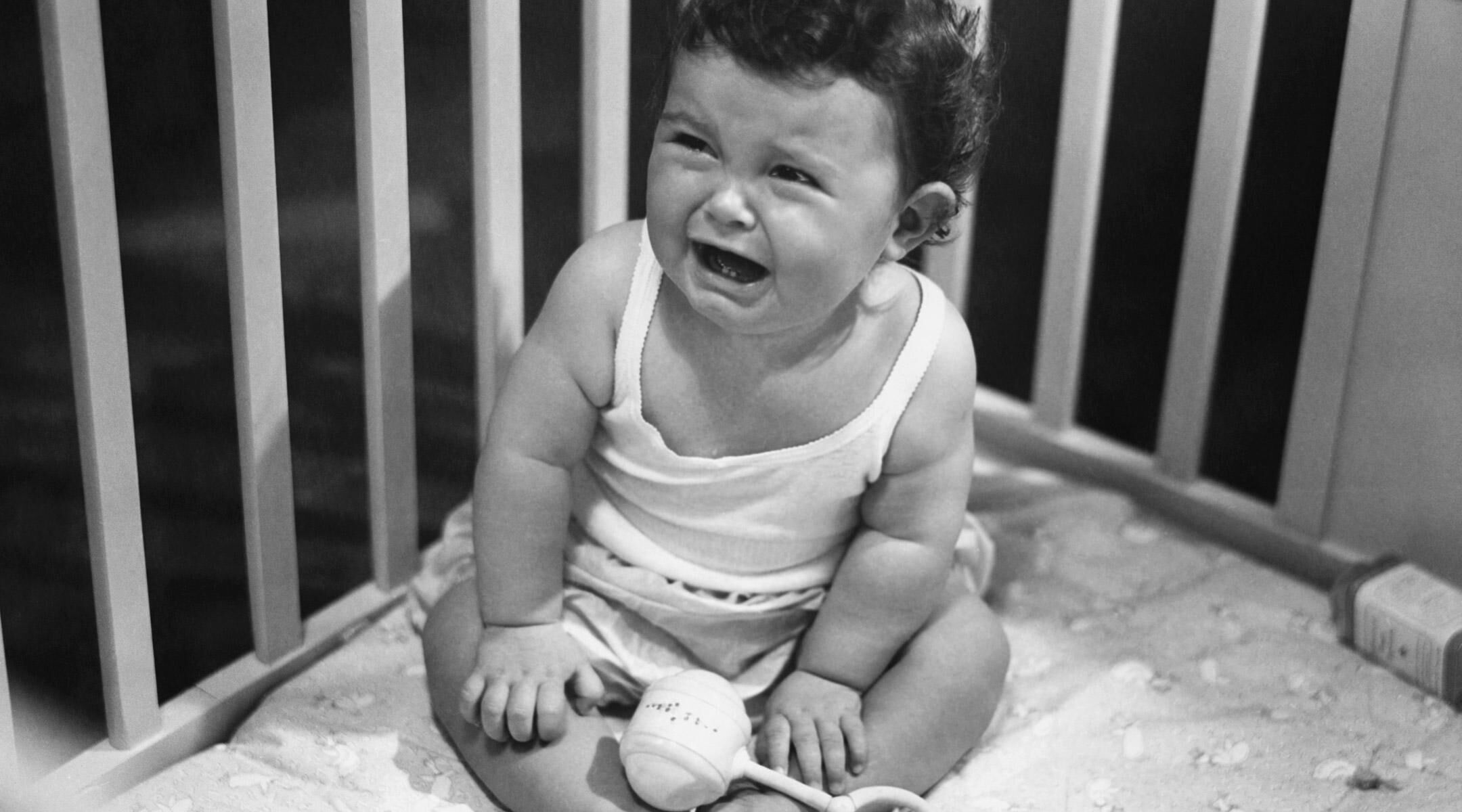What to Know About the Period of PURPLE Crying
Baby’s first cries out of the womb likely warmed your heart. They were, after all, the first sounds you heard your newborn make. But fast-forward a few weeks, and the incessant crying might not be quite as charming. In fact, it may be downright difficult to endure, and you may wonder if non-stop sobbing is the norm—or potentially unhealthy. The good news: this is completely normal. The bad news: the crying may get worse before it gets better.
In the newborn stage, babies cry a lot—and the period of PURPLE crying is a program experts developed to educate parents about what’s normal, what’s not and how to cope in the meanwhile. But exactly what is PURPLE crying (spoiler: it’s not the color baby turns during fits!), when does it stop and how can you soothe your little one during this seemingly inconsolable stage? Read on for the full lowdown from experts.
Understanding what the PURPLE program is all about can help the whole family get through this teary time. The name didn’t come about because some babies turn purple after extreme bouts of wailing—though it does seem fitting. PURPLE is actually an acronym that was developed to help parents better anticipate and understand this stage of life where healthy babies cry around the clock, explains Loretta Cody, MD, a board-certified pediatrician based in Connecticut. So what does PURPLE crying stand for? The PURPLE crying acronym means:
- Peak of crying: This is when baby wails a lot, and most of the crying may happen in baby’s second month, with less crying in months three through five
- Unexpected: There’s no rhyme or reason as to why baby starts and stops crying
- Resists soothing: Rocking, singing, bouncing, swaying—you may not be able to do anything to help soothe baby and ease the sobbing
- Pain-like face: Baby may appear to be in pain when crying, even when they’re not
- Long lasting: The crying can seem incessant—in fact, baby may cry for five hours a day or more
- Evening: The late afternoon and evening may be when baby cries the most
PURPLE crying vs. colic
According to the Johns Hopkins Medicine, colic is defined as infant crying that occurs for over three hours a day at least three days each week for over three weeks. The causes aren’t exactly known, but it could be, in part, baby’s reaction to life outside the womb (and all of the loud noises, lights and newness that come with the territory). To that end, defining the PURPLE crying period helps parents understand that, regardless of whether or not baby has been diagnosed with colic, “these phases of intense, increased crying are normal and an expected phase of development that’ll pass with time,” says Jillian Thistel, a certified pediatric sleep consultant in the Greater Toronto Area in Ontario, Canada.
When experts looked at how much babies cry during the first few months of life, they found that peak periods of crying correlated with increased incidences of shaken baby syndrome (SBS), brain injury and head trauma caused by forcibly shaking an infant. Experts believe the reason for the correlation is that some parents find themselves unable to manage the endless crying; in turn, they shake their babies in an attempt to get them to stop. Tragically, the complications associated with SBS can be deadly.
The PURPLE program was developed in the early 2000s to help parents cope during this trying stage to, ultimately, reduce the cases of SBS, explains Julie Noble, previous program director for the Period of PURPLE Crying at the National Center on Shaken Baby Syndrome. “It was a priority that the program took a child developmental approach that aimed to support caregivers and increase their understanding of normal infant crying.”
Trained health professionals, such as nurses and pediatricians, deliver the program to new parents and caregivers in medical settings. Parents typically leave the hospital with a booklet and DVD that further explain the PURPLE period, and they can also go to the National Center on Shaken Baby Syndrome to learn more.
Some preliminary research shows the implementation of the program has reduced SBS-related hospitalizations, and one survey found that 91 percent of parents agree that the PURPLE program helped them feel less frustrated when baby was crying.
As mentioned, there’s no true medical cause to explain the PURPLE crying period. “It’s the period of increased crying in healthy infants without a medical cause,” Cody says. Some experts believe it’s baby’s way of adjusting to their new environment, but while doctors aren’t sure why crying increases during this time, they have found that humans aren’t the only ones that go through this stage. Other breasted species also whimper, mewl and bleat more during the first months of life, says Adam Zolotor, MD, an associate professor of family medicine at the University of North Carolina. The indication is that this increased crying—while frustrating for you—is normal for baby during this stage of life. Of course, there are some cases where baby’s increased crying may point to something more serious (more on this below).
It’s the biggest question most parents ask: How long does purple crying typically last? According to Cody, the purple crying period usually starts when baby is around 2 weeks old and ends around the time they’re 3 to 4 months old. Some babies cry for an hour or two a day, while others may cry for up to five hours each day. While this may seem like a very long time, take heart in knowing this stage will end.
It can be incredibly challenging to cope if your infant is wailing nonstop, and it’s hard to know how to help. If baby is crying, first make sure there’s no obvious reason, including gas, needing to be changed, fed or put to bed. If none of these are the culprit, you can try the following techniques to soothe PURPLE crying in babies.
- Swaddle baby: According to the American Academy of Pediatrics (AAP), swaddling is a great way to soothe baby, reminding them of how cozy they felt in the womb. To do this, use a big, thin blanket to securely wrap up your infant. (You can ask a nurse or your pediatrician to show you how to swaddle correctly if you’re not sure how to do it.)
- Try a pacifier: The AAP notes all babies are born with the need to suck, and it’s long been proven that it can also help soothe and comfort them.
- Gently rock or sway baby: Hold baby in your arms and walk, sit or stand while gently rocking or swaying them, Cody suggests, as these calming motions may also remind babies of the womb. An infant swing can also be helpful here, she adds, as well as going for a car ride in the car seat.
- Sing to baby or use noise: Experts often cite white noise machines as helpful for soothing crying babies; it may remind them of the sounds they heard in the womb—but you might also try singing to baby. Previous research has found that singing can be incredibly soothing for babies, and the AAP also notes babies may prefer listening to familiar human voices over other sounds.
If none of these methods work, don’t panic. According to the PURPLE program, about 10 percent of the time there’s nothing that can be done to ease baby’s crying for the time being. “As a parent, we feel like we always have to do something, but sometimes there’s just nothing you can do, and it’s best to walk away, especially if you’re getting frustrated or angry,” advises Christine Baker, program coordinator of the Period of PURPLE Crying at Seattle Children’s Hospital. If you find you’re feeling too exhausted or stressed to deal with your newborn’s cries, ask a partner, family member or friend to hold baby while you take a break.
If you’re watching baby by yourself, don’t feel guilty about walking away either. Place your infant in a safe space, such as a crib or bassinet, and go into the next room until you’ve calmed down. It’s safer to give yourself a break and some breathing room while baby’s in a safe space rather than trying to power through your increasing agitation.
While the PURPLE crying period isn’t linked to an underlying medical condition, there are some instances that warrant a call to baby’s provider. These include if baby has:
- A fever of 100.4 degrees Fahrenheit or more (taken rectally)
- Decreased appetite causing signs of dehydration (such as decreased wet diapers, dry mouth and lips, sunken fontanelles and lethargy)
- Decreased alertness
Furthermore, if the crying seems excessive, or if you have a gut feeling something more serious is the matter, reach out to your child’s doctor. “Babies have a limited way of communicating, and crying is a way to let us know something’s wrong, whether the child has a fever, is constipated or has an intolerance to formula,” says Zolotor. If you’re in any way concerned about your child, it never hurts to check in with your pediatrician to give yourself peace of mind, Cody reassures.
Remember, while the crying may seem endless now, there is a light at the end of this tear-filled tunnel, and your little one will soon grow out of this sob-heavy stage. “Having a baby is hard, but knowing that this period of PURPLE crying is limited and doesn’t indicate something is wrong hopefully is reassuring for parents to know,” Cody says. “Both of my children had PURPLE crying, and this time did end!”
Please note: The Bump and the materials and information it contains are not intended to, and do not constitute, medical or other health advice or diagnosis and should not be used as such. You should always consult with a qualified physician or health professional about your specific circumstances.
Plus, more from The Bump
Christine Baker, program coordinator of the Period of PURPLE Crying at Seattle Children’s Hospital. She’s been in her role for over 20 years and received her undergraduate degree from Western Washington University.
Loretta Cody, MD, is a board-certified pediatrician based out of Connecticut. She received her medical degree from New York Medical College and completed her residency at Yale New Haven Hospital.
Julie Noble, CPST, is a child advocate at Golisano Children’s Hospital of Southwest Florida. Previously, she served as the international program director for the Period of PURPLE Crying at the National Center on Shaken Baby Syndrome for 10 years. She earned her master’s degree at National American University.
Jillian Thistel, is a certified pediatric sleep consultant in the Greater Toronto Area in Ontario, Canada. She is a member of the Association of Professional Sleep Consultants and founder of Twinkling Stars Pediatric Sleep Consulting.
Adam Zolotor, MD, is an associate professor of family medicine at the University of North Carolina. He focuses on child abuse epidemiology and prevention. He earned his master’s degree in public health and his medical degree from UNC-Chapel Hill.
National Center on Shaken Baby Syndrome, The Period of Purple Crying
National Center on Shaken Baby Syndrome, The Period of Purple Crying: Research
Johns Hopkins Medicine, Colic, 2023
Paediatrics & Child Health, The impact of an educational intervention on knowledge about infant crying and abusive head trauma, March 2016
Seattle Children’s Hospital, Period of PURPLE Crying, 2023
Healthy Children (American Academy of Pediatrics), Swaddling: Is it Safe for Your Baby?, July 2022
Healthy Children (American Academy of Pediatrics), Pacifiers and Thumb Sucking, November 2020
Paediatrics & Child Health, Pacifiers (soothers): A user's guide for parents, October 2003
Infancy Journal (The International Congress of Infant Studies), Singing Delays the Onset of Infant Distress, September 2015
Healthy Children (American Academy of Pediatrics), Hearing & Making Sounds: Your Baby's Milestones, November 2020
Learn how we ensure the accuracy of our content through our editorial and medical review process.
Navigate forward to interact with the calendar and select a date. Press the question mark key to get the keyboard shortcuts for changing dates.




















































